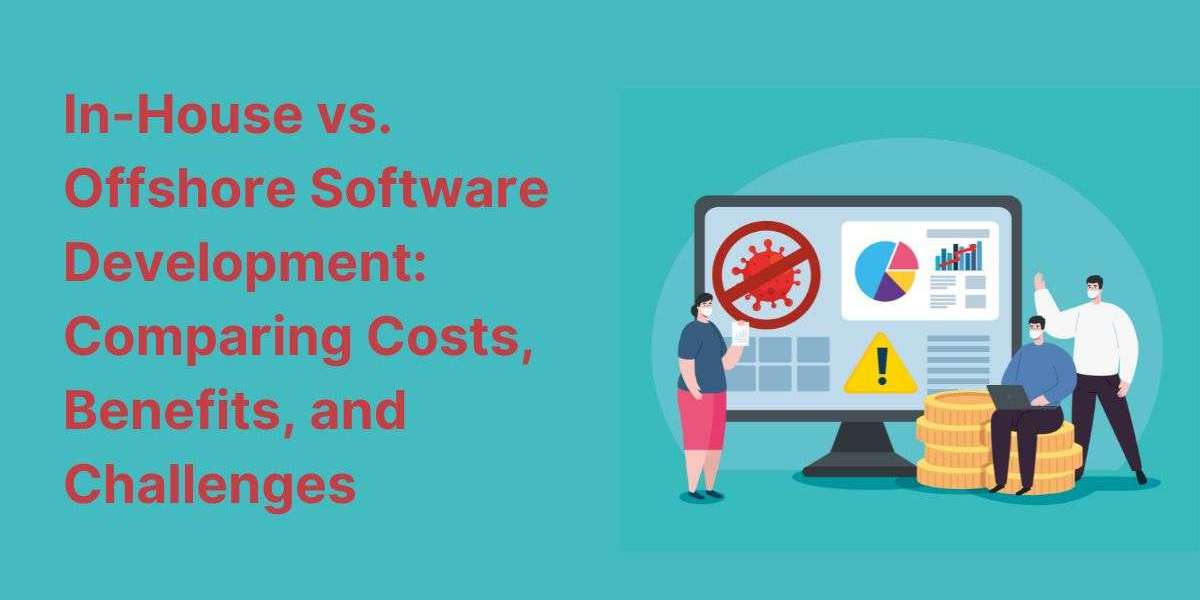When it comes to software development, many businesses face a key decision: should they build an in-house development team or go for offshore software development services? With high demand for skilled tech talent in the U.S. and other Western countries, offshore development has become a popular alternative to traditional in-house development, helping companies reduce costs and scale quickly.
This guide will compare in-house vs. offshore development, focusing on direct costs, hidden costs, productivity, and other factors. By exploring the pros and cons of each option, you’ll get insights on which approach might be best for your business.
Why Offshore Development Is Growing Fast
Top Benefits of Offshore Software Development
The offshore software development market has surged over the last decade, with businesses looking to cut costs and access specialized skills. Offshore outsourcing can reduce expenses by up to 60%, allowing companies to allocate resources to core business operations. Key offshore software development hubs include India, Eastern Europe, and Latin America, which offer highly skilled developers at competitive rates and have time zone alignment with Western clients.
In-House Development Costs vs. Offshore Development Costs
Key Costs for In-House Software Development
Salaries and Benefits: In-house developers in the U.S. can cost anywhere from $70,000 to $150,000 annually, depending on their experience and location. Employee benefits, like healthcare and retirement plans, add another 20-30% on top of salaries.
Office Space and Equipment: Office costs, particularly in tech-heavy cities like New York and San Francisco, are high, potentially reaching $100,000+ per year for a small team.
Licensing and Software Tools: Development tools can range from $500-$2,000 per developer annually, depending on tech stack requirements.
Cost Breakdown of Offshore Software Development
Lower Hourly Rates: Offshore software development rates are significantly lower, typically ranging from $20-$50 per hour depending on the country, making it a cost-effective solution.
Communication and Project Management Tools: Remote collaboration tools can cost $50-$200 per person monthly, essential for managing offshore teams effectively.
Travel Costs: For better collaboration, budget for occasional trips to meet with your offshore team, potentially costing $5,000-$10,000 per trip.
Hidden and Indirect Costs of Each Development Approach
In-House Development
Recruitment and Training: Hiring and onboarding developers take time and resources, averaging $4,000 per hire, and involve continuous training to keep skills current.
Employee Turnover: High turnover in tech results in productivity loss and costs up to 150% of the developer's salary due to transition periods.
Management and Overhead: In-house teams require dedicated project managers, HR support, and extra facilities, adding up to 20% to overall costs.
Offshore Development
Time Zone Differences and Coordination: Offshore software development teams often work across different time zones, potentially causing up to a 10% productivity loss if not effectively managed.
Language and Cultural Gaps: Cultural and language differences can impact communication; investing in training can mitigate this risk.
Quality Assurance and Oversight: Offshore projects may require more quality checks, adding 10-15% to overall project costs.
Benefits of Offshore Software Development
Global Talent Pool: Offshore outsourcing provides access to a large pool of skilled developers with specialized expertise, reducing the skill gap.
Scalability and Flexibility: Offshore teams offer flexible engagement models, allowing companies to scale up or down as project demands change.
24/7 Development Cycles: Offshore software development teams in different time zones allow for continuous development, speeding up time-to-market.
In-House vs. Offshore Development: Productivity, Quality, and Long-Term Impact
Productivity and Time-to-Market
While in-house teams benefit from face-to-face collaboration, offshore teams can work around the clock, leveraging time zones for faster project delivery. Many companies find that offshore development accelerates time-to-market by 20-30%, especially when using agile project management practices.
Quality and Technical Expertise
Offshore software development firms often specialize in certain technology stacks, enabling companies to access top-notch developers in fields like AI, blockchain, and cybersecurity. Many regions, such as Eastern Europe and India, offer highly skilled professionals who deliver quality work that meets international standards.
Case Studies: Success with Offshore and Hybrid Models
Case Study 1: Tech Startup Boosts Time-to-Market A Silicon Valley startup used offshore software development in India to build its MVP quickly and cost-effectively. This allowed them to:
Cut development costs by 60% compared to in-house hiring
Launch three months ahead of schedule
Scale from 5 to 20 developers within two months
Case Study 2: Enterprise-Level Savings with Offshore Model A large U.S. enterprise adopted a hybrid model, keeping core team members in-house and outsourcing development projects offshore. This approach resulted in:
30% reduction in development costs
25% faster project delivery
Access to niche technical skills at a fraction of the local cost
How to Make Offshore Development Work for Your Business
Prioritize Communication and Project Management: Daily check-ins, agile methods, and tools like Slack, Jira, and Asana help bridge time zone and cultural gaps.
Focus on IP and Security: Protect intellectual property with secure development practices, NDAs, and strong access controls.
Choose the Right Offshore Partner: Selecting an offshore software development partner with relevant experience, strong communication skills, and robust security measures is key to success.
Conclusion: In-House vs. Offshore Software Development – What’s Best for Your Business?
Choosing between in-house and offshore development (or adopting a hybrid approach) requires balancing cost savings with business needs. Offshore software development offers flexibility, cost efficiency, and global talent access, while in-house teams allow for more control and real-time collaboration. Many companies find that a hybrid model brings the best of both, providing flexibility and scalability while maintaining control over critical projects.
If you’re ready to explore the advantages of offshore software development, partner with a trusted provider. By carefully evaluating costs, scalability, and the strategic benefits of each model, you can make the right decision to meet your business goals.
See more service:
Hire ReactJS Developers in New York
Odoo Development Company in New York
Hire Python Development Company in New York
Hire MERN Stack Development Company in New York
Hire Full Stack Developers in New York
In-House vs. Offshore Software Development Team



